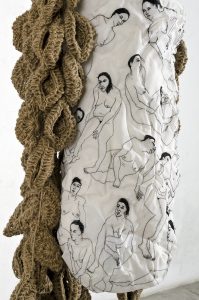By Semíramis González
Art Historian

García Callegari, G. A New American Dream Series, acrylic and pencil on canvas, 31.5×43 inches.
The series A New American Dream by artist Gonzalo García Callegari (Lima, Peru, 1971) proposes an ironic and deeply critical rereading of the stereotyped and sexist representations of women in the 1950s. These works shift between presentation and representation—between evoking the aesthetic of the golden age of the American Dream and questioning the cracks within that very model; between the hegemony of domesticity, which unambiguously confined women to roles rooted in patriarchal femininity and household labor. Based on this, García Callegari creates open works accessible to interpretation, in which apparent nostalgia transforms into symbolic denunciation, and each image is composed of multiple, often unsettling meanings.

García Callegari, G. A New American Dream Series, watercolor and pencil on photography printed on cotton paper, 19.5 x 14 inches.
The artist has emphasized that his work operates at the intersection of identity, memory, and power, always infused with irony and open to double readings. A New American Dream continues along these lines, connecting with feminist discourses that began emerging in the 1960s and 1970s—discourses that critically questioned the roles assigned to women. The “angel of the house,” the woman in the perfect home surrounded by appliances in the American suburbs, was widely promoted during the post–World War II economic boom. This was a coordinated attempt to return women to the home after they entered the industrial workforce during the war when men were fighting at the front. No historical event is neutral, and this one, as García Callegari reveals, was a reactionary response that continues to echo in the present.


García Callegari, G. A New American Dream Series, acrylic, pencil and charcoal on canvas, 31.5 x 23.5 inches.
The women in these works—with their frozen smiles, immaculate aprons, and sparkling kitchen appliances in suburban homes—are not merely visual citations. They function as critical devices. There is an explicit reference here to the “problem that has no name,” as conceptualized by Betty Friedan in her foundational text The Feminine Mystique (1963). This pivotal work anticipated the second-wave feminist demands of the 1970s. Friedan made visible the frustrations of countless American middle-class housewives, confined in their perfect homes with no future beyond caring for their husbands and children—condemned to lives devoid of autonomy or self-determination: “Why should a woman be concerned about being anything more than a wife and mother when all the forces of her culture tell her she does not have to grow, that it is better if she does not grow?” (Friedan, 2009, p. 131).

García Callegari, G. A New American Dream Series, acrylic and pencil on canvas, 43 x 35.5 inches
What García Callegari’s series brings to light: an effort to visually dismantle patriarchal discourse. His artworks weave together advertising references and domestic iconography in a style reminiscent of pop art, revealing not only a feminist critique of these ideological and sexist constructs but also how these same constructs are being reinstated today. In this context, social media becomes a new and uncritical tool for spreading a nostalgic return to order and presenting the home again as a woman’s natural destiny, as if this were somehow innocent or neutral. If in the past it was women’s magazines and television that trained women into the roles patriarchy preferred, today it is other women on social platforms who encourage one another to follow this ideologically loaded model.


García Callegari, G. A New American Dream Series, pencil and china ink on antique print, 11.5 x 8 inches.
“The personal is political,” the famous slogan of 1970s feminism, unfolds within this artistic work through an updated lens. The women in these works are not just representations but symbols of an unresolved, ongoing conflict. In this way, García Callegari transforms the sexist archive of the domestic sphere into a site of inquiry, a space for confronting patriarchal symbolism. He reveals how the private realm, still today, has been systematically stripped of value and turned into a site of unpaid labor and structural inequality.
This series invites us to look twice: on the one hand, we are drawn in by its visual appeal, its beauty, and the familiarity of what it portrays; on the other, we are immersed in a critical, committed reading. García Callegari does not merely make the stereotypes of the past visible—he confronts them with the present, dismantles them with irony, and reconfigures them through a biting aesthetic. His work makes the invisible realities of women visible and invites us to rethink the power structures that uphold those realities. With a precise and conceptually grounded style, García Callegari forces us to confront the patriarchal narrative that still shadows us—and that we must still, even today, continue to resist.

García Callegari, G. A New American Dream Series, acrylic and pencil on paper, 19.5 x 15.5 inches.



